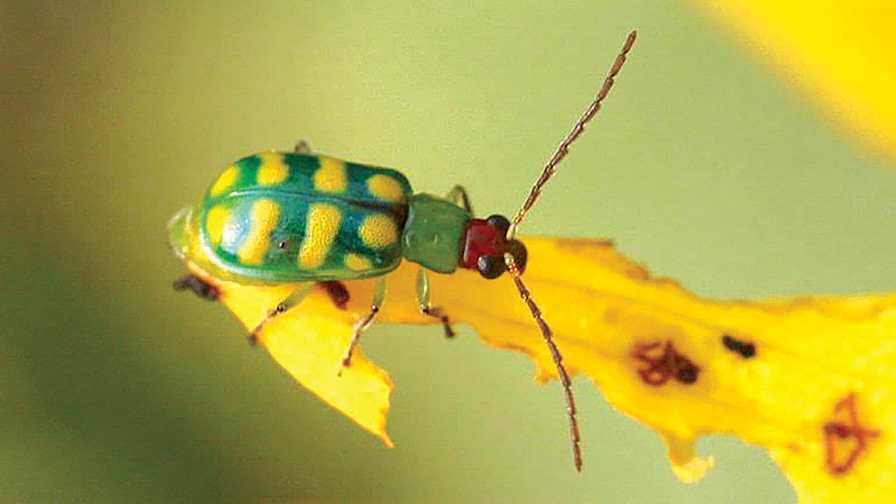Ways to Best Keep Banded Cucumber Beetle at Bay

The banded cucumber beetle is found throughout Florida, but is most common south of Tampa. It is most abundant in the organic soils near Lake Okeechobee. Photo by Russ Ottens
The banded cucumber beetle (Diabrotica balteata) is a tropical insect whose distribution has expanded over the last century throughout the southern U.S., with its northward distribution restricted by freezing temperatures.
Identification
Adults are greenish-yellow in color with a red head and black thorax. Usually there are three transverse bands and a thin, green band running down the center of the insect’s back, but the banding pattern is variable, and sometimes almost absent. Adults are good fliers and can invade and damage fields quickly.
Females deposit two to 15 egg clusters of oval-shaped, pale yellow eggs in the soil. The white, elongate, soft-bodied larvae have three pairs of minute legs and complete their development below ground feeding on roots.
Survival and Spread
The banded cucumber beetle is omnivorous, attacking numerous plant species and plant parts. While the pest prefers feeding on weeds in the genus Amaranthus, it attacks a wide range of vegetables. Vegetables affected include cucumber, squash, bean, pea, sweet potato, okra, corn, lettuce, onion, and cabbage. Damage may occur to foliage, blossoms, crown, and roots. Delayed growth, plant stunting, and stand loss can result from heavy feeding damage by adults.
Some of the most serious injury results from larval feeding on the roots of sweet potato and other vegetables. In addition to feeding damage, the banded cucumber beetle is a known vector of several pathogens, including Stewart’s wilt in corn and several viral diseases in beans. Larval feeding may also increase the incidence and severity of Fusarium wilt in cucurbits.
Management Methods
Insecticides are used to prevent damage to roots by larvae. Typically, granular insecticides are applied over the row, either at or just after planting. Numerous pesticides are labeled for treatment of cucumber beetle larvae.
Insecticides are most commonly applied during seedling emergence and during fruit development. In areas of high densities of cucumber beetles, multiple applications may be needed.
Because cucumber beetles are attracted to host plant odor, large densities of beetles may arrive within a few days of plant emergence. For this reason, scouting for beetles must be performed frequently when plants are in the seedling stage. Less frequent scouting is needed as the plant becomes more tolerant of adult feeding. Early season control of cucumber beetle adults, when warranted for seedling protection, may reduce later problems with the larvae.
There are several parasites of cucumber beetles. These include parasitic flies and wasps. They are unavailable commercially, but may play a role in the natural regulation of cucumber beetles. Several predacious insects and spiders also prey on these insects, but migration of large numbers can quickly overwhelm the natural enemies. Since many weed species host this insect, effective weed control can be valuable in reducing damage to seedlings.
Steinernema nematodes parasitize banded cucumber beetle and have been shown to be effective under experimental conditions.










